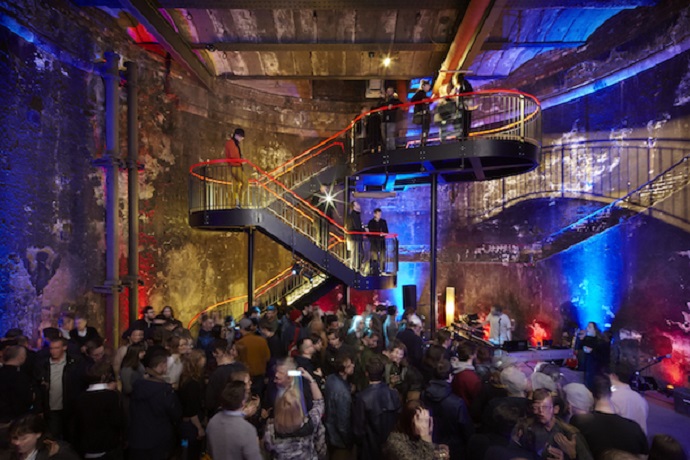
A performance at the Brunel Tunnel Shaft under the Thames. Photo: Jack Hobhouse
Throughout the 20th century, audiences wanting to hear classical music would typically go to a concert hall and sit in silence for an hour and a half. But in recent years, in a bid for new audiences, arts organisations have tried breaking down some of the stuffier elements of performances: changing the setting and format, as well as introducing visual elements. It’s an innovation that can be difficult to get right, but on 30th September, the Florentine Arts Ensemble will make their own attempt with an hour of music and art history at the National Gallery.
The performance – which complements the National Gallery’s current exhibition, George Shaw’s ‘My Back to Nature’ – was devised by founder of the Florentine Arts Ensemble, Liv-Marie Kodurand. The violinist creates events like these with the aim of finding the same source of inspiration across multiple art forms. During the evening she typically gives an overview of the selected artwork, talking about the links to the music and perhaps pulling out special musical effects which connect to the artistic movement.
But just as musicians are finding it necessary to present more than just a traditional concert programme, the same can be said for galleries. ‘It’s becoming increasingly important to provide experiences in the gallery setting, and music can be an impactful way of encouraging a visitor to slow down and linger in a gallery’, says Gill Hart, the National Gallery’s Head of Education and Events. ‘The link works best when there is a genuine empathy for visual art on the part of the musician and where there are strong links between the choice of music and the choice of painting/setting.’
The distant rumble of trains as you’re finishing a piece creates quite an amazing atmosphere.
The Modulus Quartet are part of this growing phenomenon. The group look for interesting venues where you wouldn’t typically find classical music, commissioning visual projections to display alongside the music to make it more accessible. Performing works only by living composers, they have been particularly drawn to staging events in the Brunel Tunnel Shaft under the Thames. Lead violinist Jonathan Truscott explains that ‘it’s an incredible venue. When we first went there, we had to literally crawl into the space on our hands and knees – there’s a spiral staircase now – and the distant rumble of trains as you are finishing a piece creates quite an amazing atmosphere.’
The risk of such projects however, as the Orchestra of the Age of Enlightenment discovered when it introduced its Night Shift series, is having the performance dismissed as a gimmick. But ten years on, the idea of a group of musicians like the OAE decamping from the traditional concert hall to a pub or club to interact with the audience in a more intimate setting is still going strong, and indeed has probably inspired the whole shift in concert settings. For the orchestra, it is crucial that quality is not compromised, and this seems to be the secret of its success – pitching the right programme to a new audience.
Indeed the choice of programme is key. The Birmingham Opera Company’s whole raison d’être – ‘getting opera out of its ghetto’ – involves producing performances ‘in unpredictable and unusual places, close to the streets of Birmingham.’ Their emphasis is on picking operas that they can scale down to become more mobile, as they have done with Beethoven’s Fidelio in a circus tent next to Aston Villa Football Club, and Bernstein’s Candide in a carpark in Digbeth.
You can expect to see the Florentine Arts Ensemble at work in other museums and galleries across the country. The upcoming event at the National Gallery is situated in front of Titian’s Diana paintings, and the group has delved into Titian’s inspiration for the works – Ovid’s Metamorphoses – to devise the programme of music, which includes Britten’s Six Metamorphoses and Szymanowski’s Mythes. Relocating the music, then, has produced neither dumbing down nor gimmick. ‘Each event is totally different,’ Kodurand says. ‘That’s what makes it so fascinating.’ ![]()
www.nationalgallery.org.uk/whats-on/calendar/concert-30-september-2016